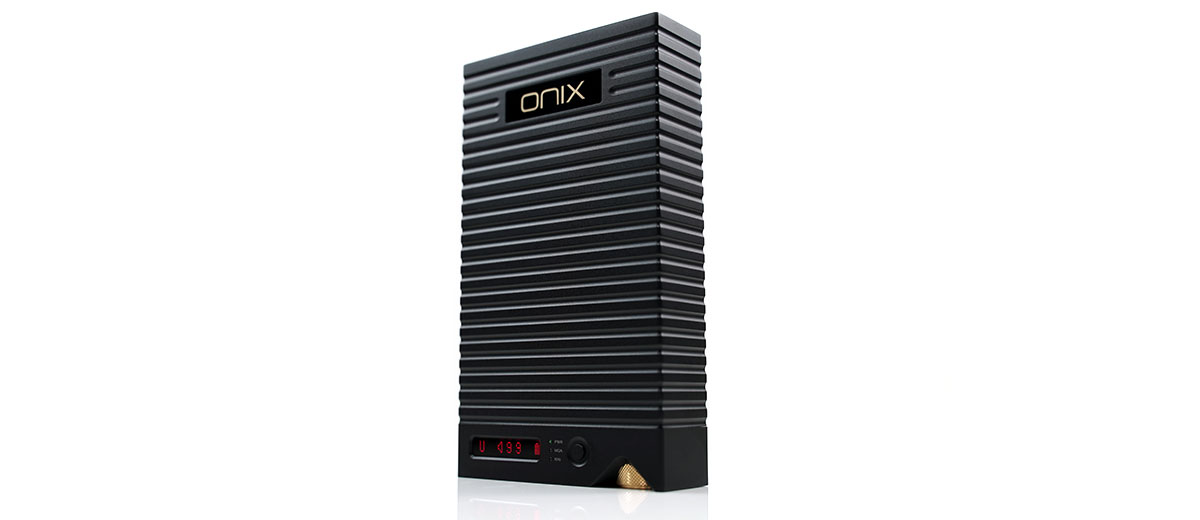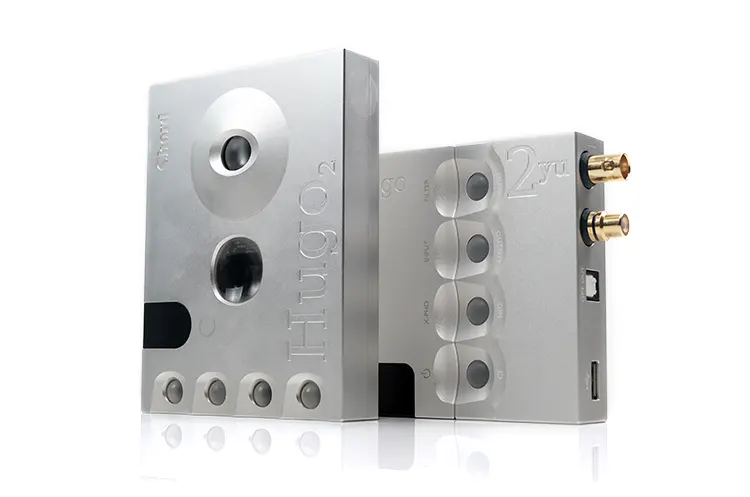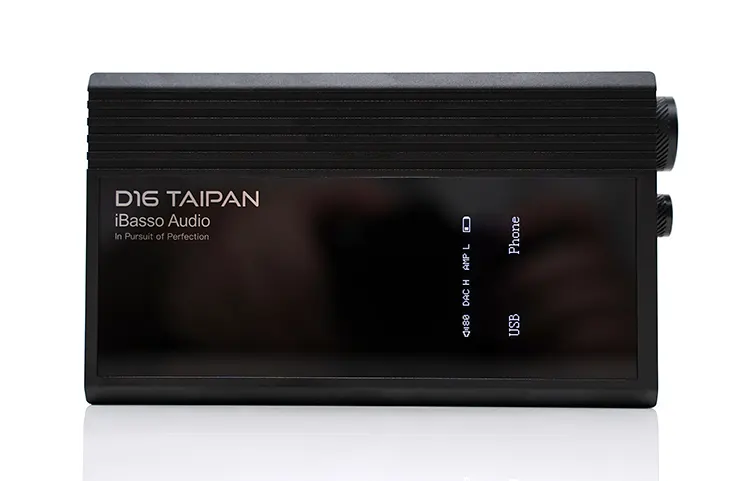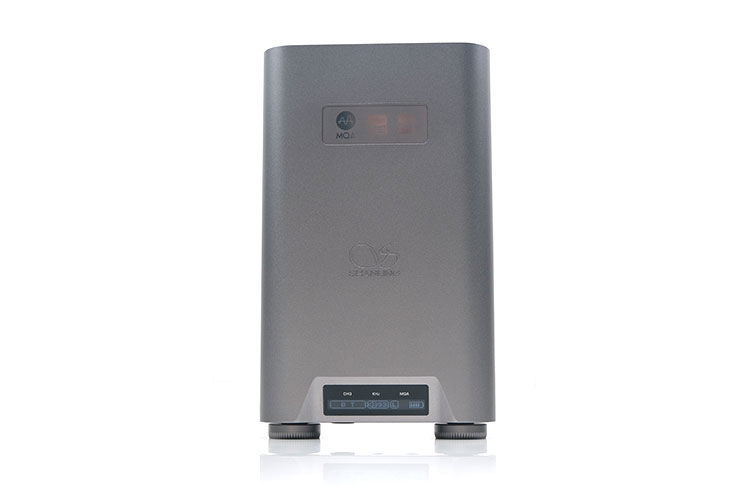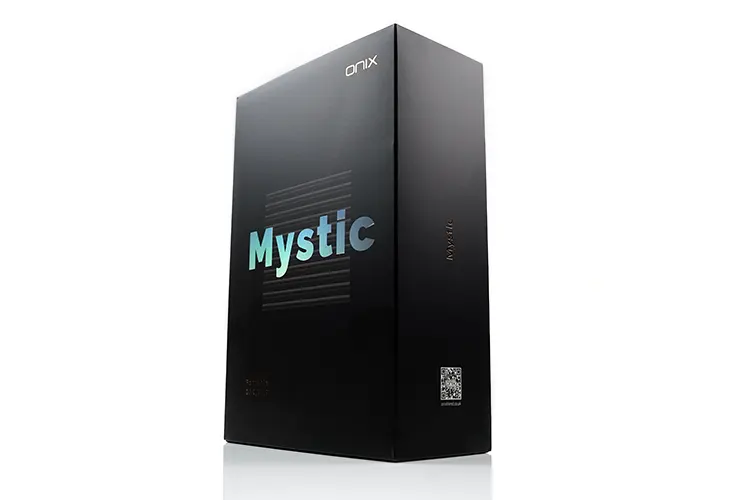Select Comparisons
The following comparisons were completed using a mix of the PMG Audio Apx and the Dan Clark Audio E3 for the pairings. All DAC/Amps were connected via USB to a Windows 10 ACER 5 Nitro laptop installed with Roon.
Chord Electronics Hugo 2
Despite its age, the Chord Electronics Hugo 2 is still considered a top choice for portable audio enthusiasts. Launched in 2017, the Hugo 2 won our Top Gear Award for Best Portable Amp/DAC in the same year.
Technical
Despite their similar price points and positioning as transportable DAC/Amps, there are several differences between these two devices.
For example, the Mystic XP1’s dual AKM AK4499EX+AK4191EQ DAC is Delta-Sigma based whereas the Hugo 2 is an in-house ‘tap-based FPGA Xilinx Artix 7 chipset using a 10-element Pulse Array design.
That means more control for Chord to shape the decoding performance of their chipsets compared to ONIX. The Hugo 2 is 7 years old when writing but still matches the Mystic XP1 for PCM and DSD decoding capability at 32BIT/768kHz and DSD512.
What the Hugo 2 does not offer is MQA. That is on company principles rather than any engineering limitation. It does have BT but not to the level of the Mystic XP1 with a maximum of aptX rather than LDAC.
The next key difference is the amplification. The Hugo 2 amplification is Class A discreet capable of up to 740mW but single-ended only for LO and PO. Again, a company choice rather than an engineering limitation.
The TPA6120A2 amplifier inside the Mystic XP1 is single-ended and balanced with a lower 211mW SE rating on battery power but slightly stronger with mains power at 812mW. It will match the Hugo 2 at 750mW from its balanced output on battery power and push ahead with its 2360mW rating when using external power.
The Mystic XP1 caveat is its high PO output impedance at 4-6Ω+. This makes it high impedance headphone friendly but could play havoc with impedance skew on some sensitive drivers in IEMs.
One minor note, the Hugo 2 is modular so adding 2go will enhance it with WiFi which the Mystic XP1 cannot offer but that adds a sizeable markup in overall ownership cost.
Design
The Hugo 2 is dimensionally a bit shorter, wider, and not as tall as the Mystic XP1. It is also over 200g lighter than the ONIX unit.
Though both use CNC-machined aluminum, the aesthetics of the Hugo 2 are rather ‘genteel’ compared to the muscular, sharper-edged visual of the Mystic XP1. Chord products are renowned for being incredibly tough and like the Mystic XP1, all sockets and ports are quite well protected.
One critique I have always had with the Hugo 2 is the orientation. With the Mystic XP1, it’s quite clear with controls and PO to the front and LO and digital input to the rear.
The Hugo 2 is more blended with a mix of digital and analog LO and PO on one end and USB input and controls on the other side, making it slightly more awkward to orientate.
The second critique is the Hugo 2 colored orb system. It’s a steep learning curve and requires referencing the manual for the meanings of the colors at the start or if you have not used it in a while. I love the articulation of the volume wheel but the Mystic XP1’s simpler OLED and LED light indicator is more intuitive.
The Hugo 2 has no app integration and no onboard local playback. To get both of those features you need the 2go module which adds to the unit size and overall cost.
There is a payoff to the investment, however, The module will give you WiFi capabilities, an app called GoFigure, and lossless transmission superior to the Mystic XP1’s LDAC ceiling.
Performance
I went with the PMG Audio Apx monitor for the initial comparison. Despite its 5Ω impedance rating, PMG uses Custom Art’s FIBAE technology which renders moot any potential for impedance mismatching.
This pairing threw up a lot of tonal and technical differences. For one, the Mystic XP1 sounds warmer, smoother, and deeper on the lows, with a more relaxed set of mids and highs.
The Hugo 2 is more neutral in its presentation with more sparkle in the highs. It projects a wider, airier, and more mids-focused presentation with an enhanced mid-bass punch.
As such the Hugo 2 midrange dynamics and vocal presence are more immediate, like having your ear closer to the driver. At the same time, it reminds me of an open-back headphone with that airier taller quality, faster transient response, and slightly tapered set of ultra-lows.
The Mystic XP1 has a closer resemblance to a closed-back headphone with the Apx pairing. Its bass shelf is more elevated, the highs a bit darker and the staging, though deeper, is slightly narrower and more center-focused.
It’s more euphonic and richer in part, with a more liquid-like vocal and instrumental timbre. It is also less likely to emphasize sibilance with a more forgiving set of highs.
The Mystic XP1 is a better choice for power and weight whereas the Hugo 2 is my preferred choice for vocal articulation and transient speed, particularly in the upper mids and highs.
One final technical note is the Mystic XP1 dynamics and energy. Compared to the punchy Hugo 2 performance I found myself using head mode rather than the ear mode. This additional voltage on tap seems to energize the bass and improve the definition compared to the smoother ear mode.
iBasso D16 Taipan
The newest release in our lineup of comparison gear, the iBasso D16 Taipan integrated amp/DAC was launched at the start of 2024 with our full review due shortly. The price point of $1499 also makes it a head-on competitor to the Mystic XP1.
Technical
The D16 is about as different as can be inside compared to the Mystic XP1. Everything inside the D16 is discrete-engineered, from the DAC to the DX320 MAX-like Class A solid-state amplification.
The 128 resistor-based 1BIT DAC inside the D16 starkly contrasts the dual delta-sigma AKM chipset inside the Mystic XP1.
We have covered 1BIT DACs before in the Cayin N7 and the RU7 reviews. Still, this one seems slightly different with 16 sets of 8E PWM-DACs (4 sets per module = 32 DAC total), backed by iBasso’s in-house FPGA-Master 2.0 algorithm for noise shaping and digital signal management operating in FIR mode.
For the user, however, the wired decoding output between both DACs is the same at DSD512 and PCM 32BIT/768kHz for USB down to 24BIT/192kHz for optical input.
The D16 does not offer wireless connectivity, so there is no BT, LDAC, app integration, or onboard local file playback. Consider this a very classic but precise low-distortion DAC design.
On battery power alone, the D16 is a little bit more powerful at up to 320mW into a 32Ω load SE, and on a 4.2V low gain balanced output setting it’s just over 560mW. Switched up to high gain and up to 6.8Vrms it seems to be closer to the 1.4W maximum power output.
Those numbers for battery power seem stronger than the Mystic XP1 but once you switch on M-power with the DC-in you get a higher Vrms at 8.1 and up to 2.35mW of balanced output power on a similar high gain mode.
Design
The D16 is smaller and lighter, more to the portable side compared to the heft of the larger Mystic XP1 but with more of an old-school portable amp vibe and not quite as modernistic as the ONIX design.
There are some similarities though with both using ribbed design accents; the D16 lines are vertical, the Mystic XP1 horizontal. They do have display screens and while the D16 screen is much bigger the font and quality of the screen are smaller and not quite as legible.
Since the D16 has no local playback it is less of an issue what size the screen is so my older eyes prefer the larger screen real estate of the D16 despite the poorer legibility at wide angles.
The Mystic Xp1 is the more complete for I/O with options for 6.35mm and 3.5mm SE and only 3.5mm SE on the D16. Both have 3.5mm and 4.4mm LO as well as 4.4mm balanced PO outputs.
The rear panel is busier on the XP1 with provision for the AUX in and DC-in for a separate power supply whereas the D16 is battery only and just SPDIF.
Like the XP1 though, the D16 has separated USB-C options for DAC and battery charging duties. Battery life is not that far off either at 9 hours for the D16 and 10 hours for the ONIX.
Performance
I tested both the PMG Audio Apx and the DCA A3 via their respective balanced outputs with both set in high gain and the Mystic XP1 in headphone mode. I would pick the Mystic XP1 for the E3 and on most occasions the D16 for the Apx.
There are several reasons for that but the primary focus is on the meatiness of the lows through to the lower mids and the vocal focus. A secondary upper mids aspect from the D16 teases out more percussion emphasis and detail but this is more track-specific.
The Mystic XP1 has a fleshier weightier sub-bass presence and a prolonged bass shelf with more warmth traveling into the lower-mids with the paired gear. The D16 sounds quite analog throughout but the emphasis on the lows is more linear and neutral in coloration and weight.
The D16 star power is through the mids with a vibrant and immediate vocal focus compared to the more laid-back, euphonic vocal presence and timbre from the Mystic Xp1.
That means the Mystic XP1 is more lows-to-mids driven whereas the D16 is more mids-to-upper-mids driven. This works better on the more relaxed and spacious nature of the Apx mids but doesn’t mix quite as well with the more mid-forward nature of the E3 pairing with some tracks sounding slightly unbalanced.
The timbre, though analog in nature, sounds drier with more upper-mid percussion sparkler coming through on the E3. In comparison, the richer and warmer tonal qualities of the Mystic Xp1 flesh out the E3 lows a bit more creating a smoother more coherent sound.
Vocals also have a more relaxed and less fatiguing tone, which is great for the E3/Mystic XP1 pairing but a bit darker and not as vibrant on the Apx.
Shanling H7
The Shanling H7 could be considered a precursor or an inspiration for the ONIX Mystic XP1. Launched in early 2023, it shares many similar features. Such was its innovative approach to the portable ADC/amp niche, we gave it our Top Gear 2023 Award for Best Portable DAC/Amp.
Technical
I consider these two to be quite close in features and positioning with the main difference more on the quality and quantity of the components used.
For example, both use the same AK4499EX+AK4191EQ DAC delta-sigma DAC chipsets with the Mystic XP1 using dual rather than a single DAC configuration inside the H7.
The decoding is similar with both units decoding up to DSD512, PCM 32BIT/768kHz, and unfolding MQA up to 8X. Both offer coaxial and optical SPDIF input up to a maximum of 192kHz/24BIT for coaxial and 96kHz/24BIT for optical.
Since both offer BT capability you can decode wirelessly up to LDAC 24BIT/96kHz and seamlessly integrate into Shanling’s Eddict app.
Another example is the amplification. The Mystic XP1 can better handle high-impedance headphones and demanding planar headphones with more output power and voltage swing when compared to the H7.
The DC-powered 2.3W output max of the Mystic XP1 is much more than the best the Shanling H7 can offer at 1300mW @32Ω.
That being said, without the DC power, the Mystic XP1 drops down to 750mW on the same load in high gain making the H7 the stronger performer on battery. The H7 is also better suited for IEMs that are sensitive to high output impedance with its less than 1Ω rating.
Design
The H7 is smaller, lighter, and comfier in the hand compared to the sizeable boxier Mystic XP1. The ONIX unit has more of a transportable feel to its dimensions more suited to sitting on a desk at times than the portable H7.
I do prefer the Mystic XP1’s control system. There is less reliance on round-robin dials and at times you can get a little frustrated with the very linear menu system from the 2 dials on the H7. Both do have a similar GUI for their local file playback since the Eddict app is compatible with both.
There isn’t a huge amount of difference in the battery performance. At 6800mAh compared to 7000mAh, it’s going to come down to the levels of load you throw into them that will determine how long they will last.
The key benefit of the Mystic XP1 is the DC-in option which allows you to bypass the battery and prolong its life whereas you can keep the H7 on USB but it is still via the battery.
The front panel IO is matching save for the 3-gain stage switch on the Mystic XP1. You also get a balanced 4.4mm line-out and an AUX in as opposed to single-ended dual RCA on the H7 and just SPDIF.
I would say the Mystic XP1 is a bit more considerate of the classic HiFi system for connectivity options for desktop use. Whereas the H7’s connectivity options in the same scenario feel a little bit more limited.
Performance
The standout difference here is what the dual DAC can bring to the Mystic XP1 over the single version from the H7.
Tonally, they are not that far off with both going for a relaxed and smooth sound signature. Rather it’s the technical side that has the greater influence here with the Mystic XP1 sounding more dynamic, more resolving, and offering a more convincing level of instrumental and vocal separation.
That technical enhancement produces better staging depth on our tested pairings so it’s not just space but an enhanced 3-dimensional projection and the superior blacker background from the Mystic XP1.
The Mystic XP1 is enhanced by the superior boost in the perceived presence at both ends of our paired gears FR. It does a better job filling every aspect of the staging space of the DCA E3 and Apx pairings.
Whereas the H7 sounds more X-Axis biased for its performance which left it ill-suited to the likes of the DCA E3 which needs more density on the lows to sound evenly balanced.
There is a stronger shelf on the Mystic XP1 so it will sound deeper and thicker on the lows compared to the H7. It also has a little more treble forwardness and sparkle, injecting the mid-timbre with some subtle sheen and tightening up the tonal contrast.
That superior level of contrast helps with midrange clarity and subtle detail which, in turn, enhances the perceived resolution coming from the Mystic XP1 pairings.
My Verdict
The ONIX Mystic XP1 is an extremely capable portable and desktop solution for those looking for a smooth but powerful-sounding high-end amp/DAC in a compact transportable form factor.
With its shared feature sets such as the TF mode, the superior dual DAC design, and bags of power it’s the logical route for Shanling H5 and H7 users to upgrade to. For headphone users, the DC-in will give you exactly what you need to drive your demanding headphones.
What does it need though to tick every box possible? Am I being petty in asking for a carry case? Maybe but it feels like it needs one to protect the unit despite it being solidly built. And of course, that high impedance means it is not going to be a match for every IEM owner, so try before you buy.
Otherwise, the ONIX Mystic XP1 seems to be another worthy competitor to the likes of the well-established Hugo 2 and the soon-to-be-reviewed new kid on the block, the iBasso D16.
ONIX Mystic XP1 Technical Specifications
- Dimensions: 160 x 92 x 30 mm
- Weight: 583g
- System Platform: Ingenic X2000
- Analog Input: 3.5mm Jack
- Bluetooth Codec Support: LDAC / aptX HD / aptX / SBC / AAC
- Hi-Res File Support: PCM 768kHz / 32bit, DSD512
- Coaxial / Optical Input: PCM 192kHz / 24bit
- Gain: 2 x 3 Levels (Earphone and Headphone mode)
- Headphone Outputs: 3.5mm & 6.5mm Single-Ended, 4.4mm Balanced
- Analog Output: 4.4mm Balanced, with pre-out function
- Battery: 7000 mAh, dedicated USB-C charging port
- Battery life: Up to 10 hours
3.5mm & 6.5mm Single-Ended Output Power:
- Headphone mode, high-gain:
- 2.6V@32Ω (211mW@32Ω) (THD+N<0.023%)
With External Power, Headphone mode, high-gain:
- 5.1V@32Ω (812mW@32Ω) (THD+N<1%)
- 6V@300Ω (120mW@300Ω) (THD+N<0.002%)
- Output Impedance: 4.7Ω
4.4mm Balanced Output Power:
- Headphone mode, high-gain:
- 4.9V@32Ω (750mW@32Ω) (THD+N<0.01%)
With External Power, Headphone mode, high-gain:
- 8.7V@32Ω (2360mW@32Ω) (THD+N<1)
- 12V@300Ω (480mW@300Ω) (THD+N<0.002%)
- Output impedance: 6.6Ω

